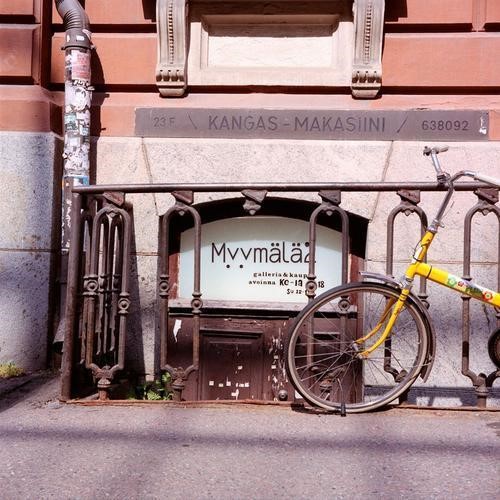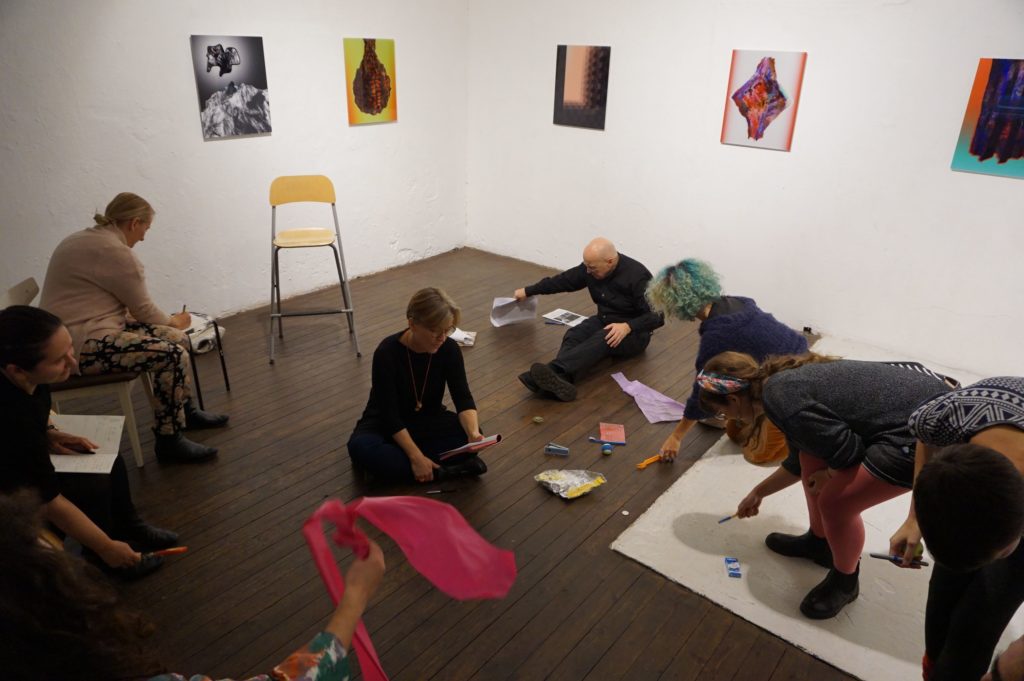text by Camila da Rosa Ribeiro
It was a rainy morning – no surprises there as it is October in Helsinki – and I was rushing to get the tram that would drop me at the door of the place where we start the second Reconnect/Recollect workshop day exploring memories of childhood. Our group in Helsinki worked on memories related to materialities. Memories of toys, boots, make up and birthday parties filled the room. I wanted to be there early that day because after chit-chatting over breakfast and initial greetings, would be the time for participants to choose a session in which we recounted our memories through art! There were 2 options: one exploring bodily sensations emerging through blindfolded dynamics in relation to childhood experiences led by Tamás Ördög (Dollar Daddy Theatre) and the second focusing on recollected memories of one’s childhood room, through performative games and multi-artistic improvisation. I was the excited person to facilitate this second option.
Like all the other 15 participants, I participated in the collective memory work: wrote my memory stories, shared them, listened to people’s questions, further detailed elements of what I was describing in the stories, worked on a second version, and cyclically shared my inputs about others’ stories. Working through the specific guidelines of the collective biography method (Davies and Gannon, 2006) was something new to me, despite working through memories in itself was not. The research I have been doing for the past years also involves tackling memories, but through approaches of performative experimentation. Therefore, some of the exercises applied in my workshop in Helsinki derived from principles, ideas or practices developed in my previous work. In the design of my session, I integrated the Reconnect/Recollect working methods with memories, keeping in mind my wish to surface new dimensions of memories through kinesthetic engagements and improvisation.

So there we were, Tamás and I, with the whole group. We were about to discover who would be the participants to take part in our respective arts sessions. The group was advised to distribute themselves evenly, and then we had half of the group taking part in each session. My group moved to another space within a 10-minute walk: to Myymälä2, a cozy art gallery that generously agreed to host our 2-hour session. Their support was fundamental for this session to happen, and myself and the project leaders are enormously grateful for it. But back to the journey towards the gallery… As we walked together, and at a point that was roughly half of the distance at an intersection, I asked the group to remember that place for later. I now ask you to do the same… We continued walking and soon arrived at the staircase leading to the gallery entrance, at the basement level. We were welcomed and led to the space designated for us.
There I proposed us standing and forming a circle to play an activation game called ‘where I come from’. Its works as follows: one participant starts at the center of the circle saying something that exists in the place where s/he comes from. In turn, whoever in the group identifies the same entity in the places where they come from, raise their hands. Those with risen hands ought to swap places, to any available place except for the one exactly next to the original. The one who didn’t find a place remains in the middle of the circle, continuing then saying ‘where I come from…’. I started the game and participated all the way through. Some of the purposes behind choosing the game include providing an informal way for participants to present themselves while affording the possibility of actively engaging with one’s physicality; opening spaces for framing personal contextual universes through rapid thinking and intuition – momentarily putting on hold the motivations and reasoning behind choices. Furthermore, the game opens spaces to trigger later reflections about the quick-thinking choices we do, surfacing the directions that our intuitive tendencies take us while framing and presenting narrative about our origins and ourselves. While I chose to use our time together for purposes other than reflecting on the choices made while playing, the game’s investigative potential remains.

We then moved to the second moment when I asked the group to use 10 minutes to write one personal memory, that they felt comfortable presenting, about the first room that they remembered living in. Some sat on the floor and others took a chair to complete the task. After the time passed, each one had a turn to read out loud the memory to familiarize ourselves with all stories. I spread different objects on the floor: they didn’t have any correspondence to each other in terms of material, weight, size or purpose. Basically, the material composed of a lot of stuff I brought from home, but despite ordinary and easily accessible, the objects were carefully chosen for the distinguishing sounds they bring in themselves. And being there, spread out across the room, they were presented to be manipulated to compose the sound landscape of every individual memory. I asked each participant to come to the middle of the circle and re-read one’s text on a loop for a few times as the others were experiment-as-compose soundscapes. These either corresponded or evoked situations, actions, atmospheres and characters presented in the memory texts.
These moments where filled with laughter and that was completely OK. Collective performing entangles enjoyment, and here joy partly came from witnessing the reveal of peers’ more playful facets and from the surprises arising when listening to unusual sounds and how their composition jangle together. But interestingly enough, the pleasure of joy acts as an activating force that here motivated the listeners to also produce their own sounds, keeping the surprise and enjoyment loop going. Enjoyment was a fundamental part of this session, tempering the relationships among participants and paving the way for new memory insights and recollection.
By the time we heard everyone’s story, it was time to start heading back to the place we originally met in the morning. But before leaving, I asked the participants to gather in duos so that they could do the final activity on their way: doing a private “bullshit guided tour” for the person walking with them. As the self-explanatory title stated, one person would act as the tour guide who could freely elaborate narratives about the history of the place according to the things seen along the way (buildings, shops, traffic signs, street names, colors, etc. etc.). The place I highlighted to the group before arriving at the gallery, at the intersection of streets, was my suggested cue for changing ´guide´ and ´tourist´ roles. As we were on an uneven number, I didn’t take a pair for myself but was able to enjoy snippets of the guided tours offered by others. Participants mobilized their imagination to explain names, liturgic rituals, what people had to achieve in order to receive the honour of having their names as street titles…
It was a privilege for me to be involved in this seemingly drifting performative moment because it allowed me to sense the contrast that it offered in relation to the dynamics we were engaged with the entire group. I noticed that such an approach offered a complimentary experience. Besides, it was the first time that I facilitated a performance autobiography workshop with a group that wasn’t completely formed by artists. I was able to feel the impact it had on softening affective relationships and providing game-measured degrees of spontaneity. Furthermore, the overall workshop experience launched an immersion into my PhD studies at Tampere University (initiated about two months before the workshop) and housed what was about to become one of my professional-affective communities.
More information about Myymälä2 gallery_
